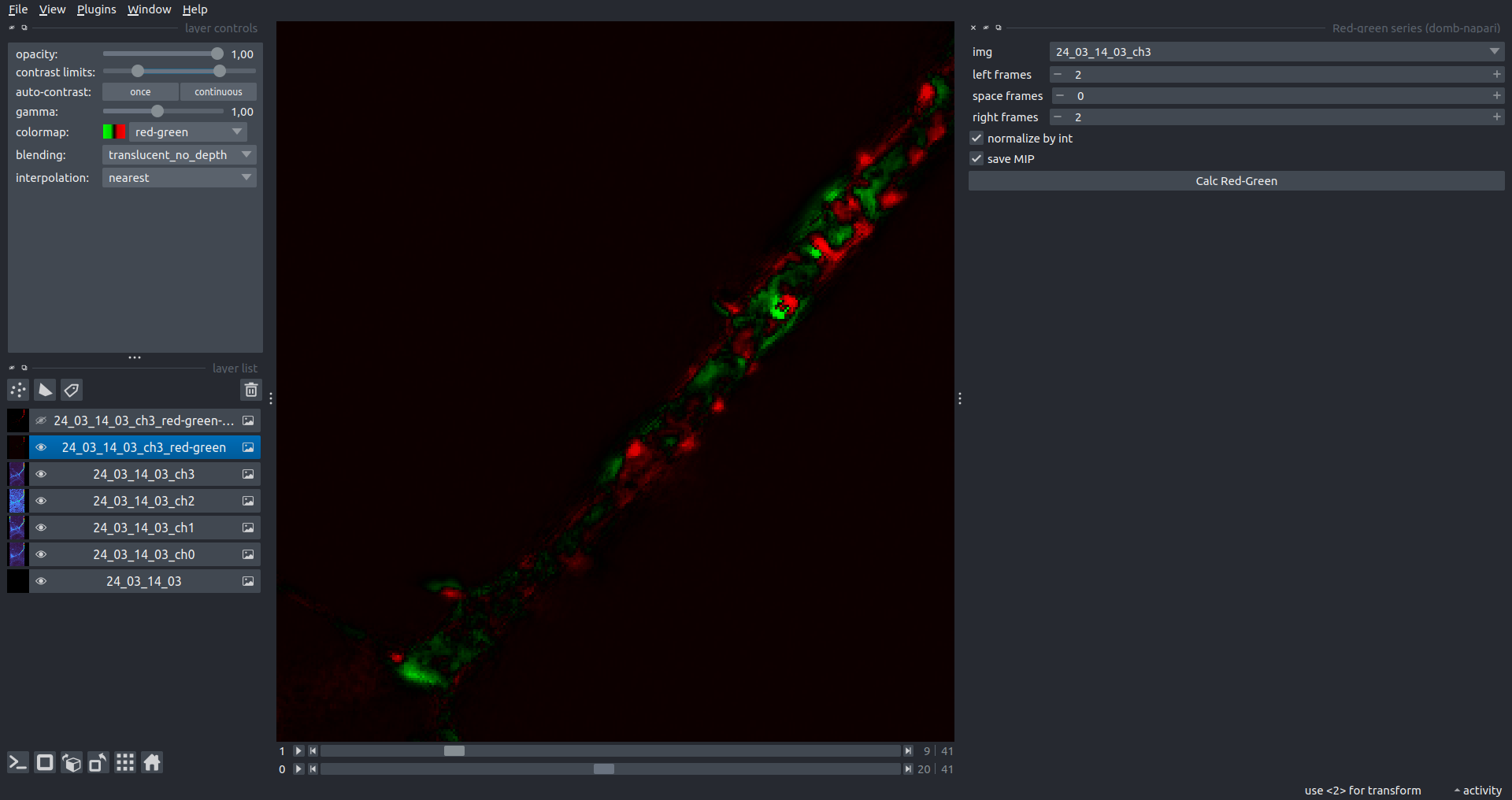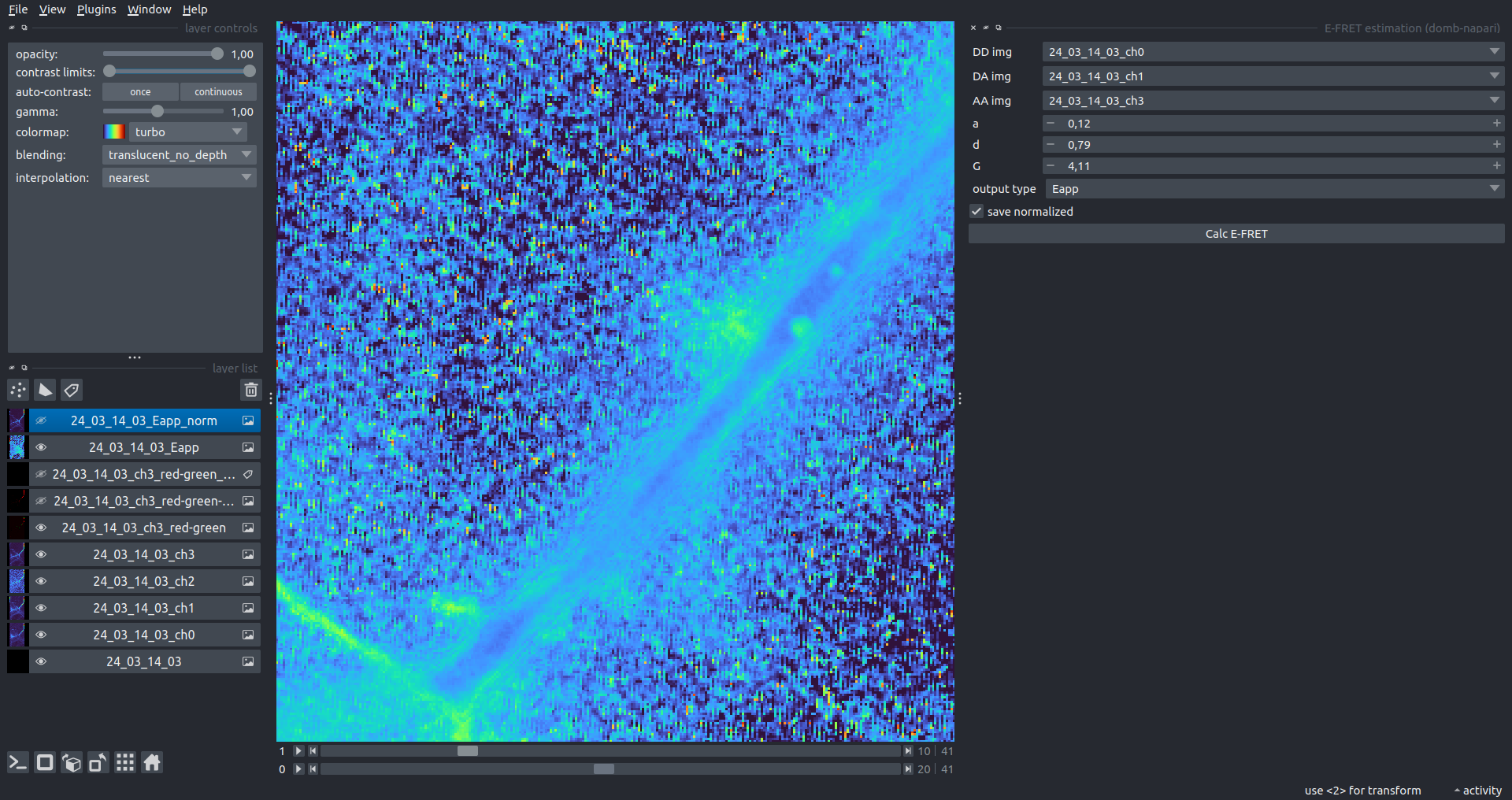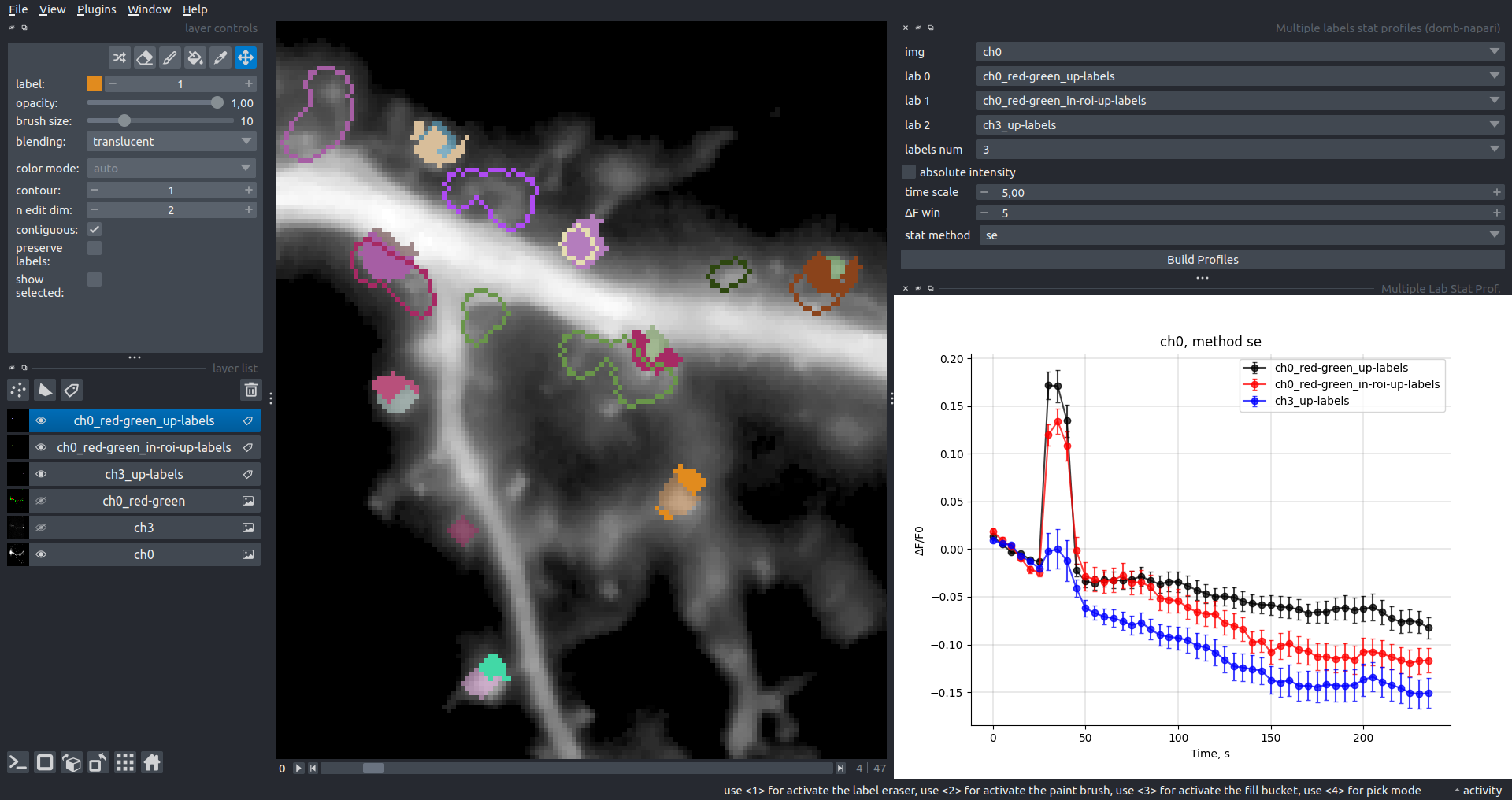domb-napari
napari plugin for analyzing the redistribution of fluorescence-labeled proteins
domb-napari
napari Toolkit of Department of Molecular Biophysics
Bogomoletz Institute of Physiology of NAS of Ukraine, Kyiv, Ukraine
This plugin offers widgets specifically designed to analyze the redistribution of fluorescence-labeled proteins in widefield epifluorescence time-lapse acquisitions. It is particularly useful for studying various phenomena, including:
- Calcium-dependent translocation of neuronal calcium sensors.
- Synaptic receptor traffic.
- Membrane protein tracking.
 Hippocalcin (neuronal calcium sensor) redistributes in dendritic branches upon NMDA application
Hippocalcin (neuronal calcium sensor) redistributes in dendritic branches upon NMDA application
Preprocessing
Dual-view Stack Registration
Registration of four-channel image stacks, including two excitation wavelengths and two emission pathbands, acquired with a dual-view beam splitter. This setup detects different spectral pathbands using distinct sides of the camera matrix.
offset img- input for a four-channel time-lapse image stack.reference img- an optional four-channel reference image (e.g., fluorescence beads image), used for offset estimation ifuse reference imgis selected.input crop- number of pixels that will be deleted from each side of input stack frames to discard misalignment artifacts from the dual-view system.output crop- number of pixels that will be deleted from each side of output stack frames to discard registration artifacts.
Multichannel Stack Preprocessing
stack order- represents the order of axes in the input data array: T (time), C (color), X, and Y (image dimensions). If the input image stack has four dimensions (time, channel, x-axis, y-axis), channels will be split into individual three-dimensional images (time, x-axis, y-axis), each labeled with the_ch%index%suffix.median filter- provides frame-by-frame image smoothing with a kernel of size specified inmedian kernel.background subtraction- compensates for background fluorescence intensity. Background intensity is estimated frame by frame as the 0.5 percentile of frame intensity.- If the
photobleaching correctionoption is selected, the image will undergo correction using either an exponential (methodexp) or bi-exponential (methodbi_exp) fitting. - Image stacks can be cropped according to start and stop indexes specified in
frames rangeifdrop framesis selected.

Detection of Fluorescence Redistribution
A set of widgets designed for preprocessing multispectral image stacks and detecting redistributions in fluorescence intensity. These widgets specifically analyze differential "red-green" image series to identify changes in fluorescence intensity.
Inspired by Dovgan et al., 2010 and Osypenko et al., 2019.
Red-Green Series
Primary method for detecting fluorescence-labeled targets redistribution. This widget returns a series of differential images, each representing the intensity difference between the current frame and the previous one, output image labeled with the _red-green suffix.
Parameters:
left frames- specifies the number of previous frames used for pixel-wise averaging.space frames- determines the number of frames between the last left frame and the first right frame.right frames- specifies the number of subsequent frames used for pixel-wise averaging.
normalize by int function normalizes the differential images relative to the absolute intensity of the input image stack, which helps to reduce background noise amplitude.
If save MIP is selected, the maximal intensity projection (MIP) of the differential image stack will be saved with the _red-green-MIP suffix.

ΔF & ΔF/F Series
In progress.
Masking
Dots Pattern Masking
Creates labels for bright dot elements on an image, such as pre- and postsynaptic fluorescence markers (e.g., Bassoon/Synaptobrevin for presynapses, PSD-95/Homer for postsynapses, etc.). It returns a labels layer with the _dots-labels suffix.
The widget detects the location on the MIP (Maximum Intensity Projection) of the input time series image and applies simple round masks to each detected dot. Watershed segmentation is then used to prevent the merging of overlapping masks.
Parameters:
background level- Background level for filtering out low-intensity elements. This is specified as a percentile of the MIP intensity.detection level- Minimum intensity of dots, specified as a percentile of the MIP's maximum intensity.mask diameter- Diameter in pixels for the round mask of each individual dot.minimal distance- Minimum distance in pixels between the centers of individual round masks.
 Hippocalcin (green) and PSD95 (magents) in dendritic branches
Hippocalcin (green) and PSD95 (magents) in dendritic branches
Up Masking
Generates labels for regions with high intensity based on raw or -red-green images. Returns a labels layer with the _up-labels suffix.
The widget provides two detection modes:
- Global masking with a fixed threshold for the entire image.
- In-ROIs masking with a loop over individual ROIs in the input
ROIs maskwith separate detections.
Parameters:
det frame index- index of the frame from the input image used for label detection.det th- treshold value for detecting bright sites, where the intensity on the selected frame is normalized in the range of -1 to 0.in ROIs det- option for activating in-ROIs masking.in ROIs det method- method for in-ROIs masking; otsu provides simple Otsu thresholding, while the threshold method is identical to global detection on nomilized detection frame.in_ROIs_det_th_corr- caling factor for the det th threshold value for in-ROIs masking.final opening fp- footprint size in pixels for mask filtering using morphological opening (disabled if set to 0).final dilation fp- footprint size in pixels for mask morphological dilation (disabled if set to 0).save total up mask- if selected, a total up mask (containing all ROIs) will be created with the _up-mask suffix.
 Gplobal up labels
Gplobal up labels
The In-ROIs masking option can be particularly useful for co-localization detection. By applying a broad reference mask to several target images, you can create more precise labels for ROIs in specified cell compartments. The following examples demonstrate the detection of mutual locations for static PSD-95 enriched sites (postsynaptic membranes) and HPCA translocation sites only in the vicinity of synapses, using _dots-labels for PSD95-mRFP images.
Note: In the In-ROIs masking mode, labels of detected sites correspond to the matching labels from the input ROIs mask.
| In-ROIs masking (reference) |  |
|---|---|
| In-ROIs maskin (translocation) |  |
| Masks overlay |  |
Intensity Masking
Extension of Up Masking widget. Detects regions with increasing (masking mode - up) or decreasing (masking mode - down) intensity in -red-green images. Returns a labels layer with either _up-labels or _down-labels suffix, depending on the mode.

3-cube E-FRET Approach
Widgets for detection and analysis of Förster resonance energy transfer on multispectral image stacks.
Based on notation and approaches from Zal and Gascoigne, 2004, Chen et al., 2006 and Kamino et al., 2023.
E-FRET Crosstalk Estimation
In progress.
Estimation of the crosstalk/bleedthrough of fluorescence between the donor and acceptor’s spectral channels.
F_c = I_{DA} - a (I_{AA} - c I_{DD}) - d (I_{DD} - b I_{AA})
F_c = I_{DA} - a I_{AA} - d I_{DD} \; \text{if} \; b \approx c \approx 0
a = \frac{I_{DA(A)}}{I_{AA(A)}}
b = \frac{I_{DD(A)}}{I_{AA(A)}}
c = \frac{I_{AA(D)}} {I_{DD(D)}}
d = \frac{I_{DA(D)}} {I_{DD(D)}}
b \approx c \approx 0
Parameters:
DD img- donor emission channel image acquired with the donor excitation wavelength.DA img- donor emission channel image acquired with the acceptor excitation wavelength.AD img- acceptor emission channel image acquired with the donor excitation wavelength.AA img- acceptor emission channel image acquired with the acceptor excitation wavelength.mask- .presented_fluorophore- .saving_path- .
E-FRET G-factor Estimation
In progress.
G = \frac{(I_{DA} - a I_{AA} - d I_{DD}) - (I_{DA}^{post} - a I_{AA}^{post} - d I_{DD}^{post})}{I_{DD}^{post} - I_{DD}} = \frac{F_c - F_{c}^{post}}{I_{DD}^{post} - I_{DD}} = \frac{\Delta F_c}{\Delta I_{DD}}
\Delta F_c = G \cdot \Delta I_{DD}
E-FRET Estimation
Estimation of the E-FRET with 3-cube approach.
E_{app} = \frac{R}{R+G}
R = \frac{F_c}{I_{DD}}
ECFP and EYFP Setup:
- Microscope Olympus IX71
- Camera PCO Sensicam QE
- Cube Chroma 69008
- Dual-view system with Chroma 505DCXR beam splitter
- Donor excitation wavelength 435 nm
- Acceptor excitation wavelength 505 nm
TagBFP and mBaoJin Setup:
- Microscope Olympus IX71
- Camera PCO Sensicam QE
- Cube Chroma 69002
- Dual-view system with Chroma 505DCXR beam splitter
- Donor excitation wavelength 405 nm
- Acceptor excitation wavelength 495 nm
This method utilizes default values of a and d coefficients and the G-factor for TagBFP and mBaoJin pair.
Parameters:
DD img- donor emission channel image acquired with the donor excitation wavelength.AD img- acceptor emission channel image acquired with the donor excitation wavelength.AA img- acceptor emission channel image acquired with the acceptor excitation wavelength.output type- type of output image: sensitized emission (Fc), apparent FRET efficiency (Eapp), or FRET efficiency with photobleaching correction (Ecorr).
If the save normalized option is selected, an additional image will be saved. This image is normalized to the absolute intensity of the AA img, which results in reduced background noise amplitude.
Note: normalized images are useful for visual control and mask building only; they are not representative for quantitative analysis.
| Raw Eapp |  |
|---|---|
| Normalized Eapp |  |
Exo/Endo-cytosis Monitoring with pH-Sensitive Tag
A set of widgets designed for the analysis of image series containing the pH-sensitive fluorescence protein Superecliptic pHluorin (SEP).
Insipred by Fujii et al., 2017 and Sposini et al., 2020.
SEP image preprocessing
Processes image series obtained through repetitive pH exchange methods (such as U-tube or ppH approaches). pH 1st frame option indicates the 1st frame pH. By default frames with odd indexes, including index 0, are interpreted as images acquired at pH 7.0, representing total fluorescence intensity (saved with the suffix _total). Even frames are interpreted as images obtained at acidic pH (5.5-6.0), representing intracellular fluorescence only (saved with the suffix _intra).
If calc surface img is selected, an additional total fluorescence image with subtracted intracellular intensity will be saved as the cell surface fluorescence fraction (suffix _surface). The input image should be a 3-dimensional single-channel time-lapse.
The calc projections option allows obtaining individual pH series projections (pixel-wise series MIP - pixel-wise series average) for the detection of individual exo/endocytosis events.
Plotting and Data Frame Saving
ROIs Profiles
This widget builds a plot with mean intensity profiles for each Region of Interest (ROI) in labels. It uses either absolute intensity (if absolute intensity is selected) or relative intensities (ΔF/F0).
Parameters:
time scale- sets the number of seconds between frames for x-axis scaling.values mod- the mode of output profile calculation. Options areΔF/F0(relative intensity changes),ΔF(absolute intensity changes), orabs(absolute intensity value)ΔF win: if theuse_simple_baselineoption is selected, the baseline intensity is estimated as the mean intensity of the specified number of initial profile points. Otherwise, this parameter specifies the window half-size of the moving median baseline estimator (noisy_medianfrom thepybaselinespackage).profiles crop- if selected, only a specified range of intensity profile indexes will be plotted, corresponding to the start and stop indexes fromprofiles range.
| Absolute intensity |  |
|---|---|
| ΔF/F0 |  |
Multiple Images Stat Profiles
This widget builds a plot displaying the average intensity of all Regions of Interest (ROIs) specified in lab. It can handle up to three images (img 0, img 1, and img 2) as inputs, depending on the selected profiles num.
time scale, values mod, and ΔF win parameters are identical as described in the ROIs profiles widget.
The stat method allows estimation of intensity and associated errors using the following methods:
se- mean ± standard error of the mean.iqr- median ± interquartile range.ci- mean ± 95% confidence interval (t-distribution).
| Absolute intensity |  |
|---|---|
| ΔF/F0 |  |
Multiple Labels Stat Profiles
This widget builds a plot displaying the averaged intensity of all Regions of Interest (ROI) for one target img. It can handle up to three labels (lab 0, lab 1, and lab 2), depending on the selected profiles num.
time scale, values mod, and ΔF win parameters are identical as described in the ROIs profiles widget.
The stat method allows estimation of intensity and associated errors using the following methods:
se- mean +/- standard error of the mean.iqr- median +/- interquartile range.ci- mean +/- 95% confidence interval based on the t-distribution.
| Absolute intensity |  |
|---|---|
| ΔF/F0 |  |
Save Data Frame
This widget enables you to save the data frame in CSV format. This is particularly useful for exporting results after examining them with the ROIs Profiles widget.
Parameters:
img- input for a single channel time series image stack.lab- input for a labels layer with ROIs.stim position- input for a points layer with stimulation electrode position, should contain a single point only.time scale- sets the number of seconds between frames for frames indexes scaling.ΔF win: if theuse_simple_baselineoption is selected, the baseline intensity is estimated as the mean intensity of the specified number of initial profile points. Otherwise, this parameter specifies the window half-size of the moving median baseline estimator (noisy_medianfrom thepybaselinespackage).save ROIs distances- if selected, the average distance in pixels from the ROI to the frame will be saved in the data frame.custom stim position- if selected, a custom stimulation electrode position fromstim positionlayer will be used for distance calculations.saving path- path to save the data frame.
The output data contains the following columns:
id- unique image ID, the name of the inputnapari.Imageobject.lab_id- unique label ID, the name of the inputnapari.Labelsobject.roi- ROI number, consecutively numbered starting from 1.dist- average distance in px to the ROI from the frame, (ifsave ROIs distances in data frameoption is selected).index- frame index.time- frame time point, adjusted according to thetime scale.abs_int- absolute intensity value.dF_int- absolute intensity changes (ΔF).dF/F0_int- relative intensity changes (ΔF/F0).
How to Cite
If you use this plugin in your work, please cite the following paper:
@article{Olifirov2025,
title = {Local Iontophoretic Application for Pharmacological Induction of Long-Term Synaptic Depression},
volume = {15},
ISSN = {2331-8325},
url = {http://dx.doi.org/10.21769/BioProtoc.5338},
DOI = {10.21769/bioprotoc.5338},
number = {1373},
journal = {BIO-PROTOCOL},
publisher = {Bio-Protocol, LLC},
author = {Olifirov, Borys and Fedchenko, Oleksandra and Dovgan, Alexandr and Babets, Daria and Krotov, Volodymyr and Cherkas, Volodymyr and Belan, Pavel},
year = {2025}
}
or zenodo:
@misc{https://doi.org/10.5281/zenodo.14843770,
doi = {10.5281/ZENODO.14843770},
url = {https://zenodo.org/doi/10.5281/zenodo.14843770},
author = {wisstock, },
title = {wisstock/domb-napari: Zenodo release v0.3.0},
publisher = {Zenodo},
year = {2025},
copyright = {MIT License}
}
Version:
- 0.5.0
Last updated:
- 2025-11-11
First released:
- 2024-03-01
License:
- Unavailable




